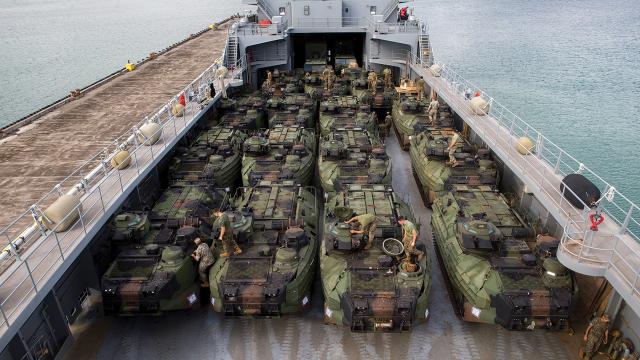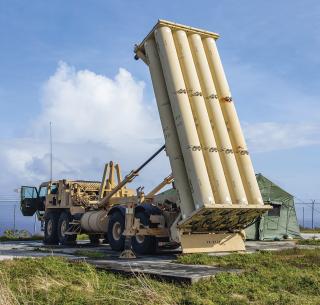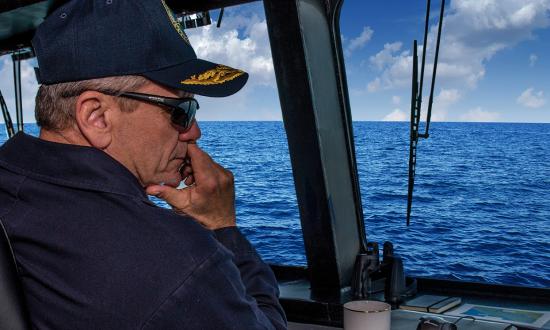While recent articles in the American Sea Power Project have focused primarily on how the Navy and Marine Corps would be employed in the War of 2026 scenario, most authors directly or indirectly point to the need for joint and combined-arms solutions. As Toshi Yoshihara and James Holmes point out in their seminal book Red Star Over the Pacific, “Seapower is about far more than fleets. Indeed, it is about more than navies.”1 And nowhere is sea power more important to U.S. national interests than in the Indo-Pacific. The region justifiably carries special meaning for the Sea Services, but the U.S. Army has its own distinguished history in the nation’s current priority theater.
Today, as before, the Army has much to offer in terms of capability and capacity. Making the most of those contributions, however, will require overcoming the friction that historically has dogged interservice cooperation. This is especially true in an environment demanding “jointness” above all else, given its variety of threats, complexity, diverse terrain, and immense distances.
It is important to acknowledge a significant difference between the wars in Iraq and Afghanistan and today’s challenges in the Indo-Pacific. Throughout Operations Iraqi Freedom and Enduring Freedom, land forces composed the main effort to root out insurgent networks and transition local control to host-nation forces, trained largely by the Army. Consequently, the other services conformed to the Army’s preferred methodologies, systems, and approaches.
The opposite is true in the competition and potential conflict with China. The Army must therefore “transform in contact”—to borrow a phrase from Army Chief of Staff General Randy George—not only to meet the demands of land operations but also to support and enable the other services—especially in a theater named for two oceans. While change is hard, the Army is determined to excel in its critical roles and functions in the Indo-Pacific.
Asymmetric Advantage
China seeks to exploit key terrain through excessive territorial claims meant not only to coerce local populations such as Taiwan’s, but also to gain control over some of the world’s most strategic waterways. By building artificial islands in the South China Sea and arming them with antiship and antiaircraft missile systems, the People’s Liberation Army (PLA) has effectively extended its antiaccess/area-denial (A2/AD) network far beyond the Chinese mainland. Notably, China has designed its A2/AD arsenal to defeat U.S. naval and air forces and to disrupt and degrade U.S. space and cyber capabilities. However, its arsenal is not designed to find, fix, and finish distributed, mobile, networked, reloadable land forces.
As Yoshihara and Holmes put forward, herein lies an opportunity for land-based fires to offer a “low-cost, high-payoff” advantage to the Sea Services, particularly to naval forces.2 Indeed, countering the enemy’s naval forces from land is an ancient idea. Alexander the Great defeated the Persian fleet in 332 BC by reducing its fortified naval bases during a land campaign, leaving the fleet to wither at sea.3 The potential today is clear: Land-based fires can shut down key maritime choke points from extended distances.
“A ship’s a fool that fights a fort” is one of the six cornerstones of naval tactics Wayne Hughes identified in Fleet Tactics and Naval Operations.4 Attributed to Admiral Lord Horatio Nelson, the maxim is taking on new meaning because land-based fires no longer offer a solely defensive capability with limited range. Instead, they now can strike defensively and offensively far out to sea. In 2017, Admiral Harry Harris, then–Commander, U.S. Pacific Command, turned the idea of China’s A2/AD on its head by calling on the Army to sink ships.5 The Army has pursued that goal ever since.
The technology needed to sink ships from land, at range, and with precision is fast approaching delivery. The Army’s midrange capability is on track to deploy in the near term, offering ground-launched Tomahawk and SM-6 missiles with the ranges and warheads needed to defeat naval targets. The Precision Missile (PrSM) Increment 2 features an antiship seeker, and the PrSM Increment 4 is expected to strike targets beyond 1,000 kilometers. The Army also has accelerated research and development of long-range hypersonic weapons (LRHW) in close cooperation with the Navy. Of note, the first LRHW battery was fielded at Joint Base Lewis-McChord last year and is assigned to U.S. Indo-Pacific Command.
Furthermore, the Army is well underway toward realizing the concept Dr. Carol Evans of the U.S. Army War College describes as a “Ring of Fires.”6 On Amami Island in the Ryukyu chain, the U.S. Army High Mobility Artillery Rocket System (HIMARS) and Japan Ground Self-Defense Forces (JGSDF) Type-12 antiship missile system operators now regularly train together as part of the long-standing army-to-army exercise Orient Shield. In the Luzon Strait, last year for the first time, the U.S. Army, U.S. Marine Corps, and the Armed Forces of the Philippines conducted an antiship live-fire exercise on Basco Island. Similar efforts are planned elsewhere.
Positioning the Army’s land-based fires network on key terrain inside the first island chain delivers a force multiplier to the fleet by holding the adversary’s critical capabilities at risk via cross-domain strike. Moreover, Army fires would complement the Marine Corps’ concept of stand-in forces, not only by adjoining more firing platforms—adding much needed capacity to counter the PLA’s mass—but also by linking those expeditionary forces with the accompanying Army support and joint enabling capabilities that increase survivability and allow for prolonged operations.
Albert Palazzo at the University of New South Wales in Canberra, Australia, predicts land-based fires will be the newest determining factor in the maritime domain. “Now land forces, armed with long-range missiles supported by sensing and targeting systems, will change how sea control is achieved or denied,” he writes.7 While ground-launched missiles will not take the place of a seagoing fleet, these capabilities can contribute profoundly, particularly the kinetic and nonkinetic capabilities in the Army’s multidomain task forces (MDTFs). Two MDTFs are assigned and operating in the Indo-Pacific today; a third is planned for the region.
In these ways, the Army, in conjunction with the Sea Services, could prevent China from gaining the level of sea control required to impose its will on Taiwan and in the South China Sea. According to Palazzo’s thesis, using land-based fires to hold the adversary’s critical maritime capabilities at risk could deprive him of command of the sea.
Maneuver is always required to achieve such an outcome. Land-based fires alone cannot counter the PLA Navy at sea, and fires traditionally enable maneuver. In the War of 2026 scenario and as seen throughout World War II in the Pacific, maneuver forces from the Army, Marine Corps, and land forces of U.S. allies and partners, would be required to seize, hold, and defend the numerous land areas essential for projecting, protecting, and sustaining sea power.
Unity of Effort
Defeating a Chinese invasion of Taiwan would be possible only if U.S. allies and partners embrace their own stake in the outcome. The Army’s Security Force Assistance Brigades (SFABs) have become a dedicated means to train, advise, assist, enable, and accompany operations with allied and partner nations.
The SFABs’ contributions extend beyond tactical training with host-nation military forces, having evolved into the leading edge
of long-term strategic competition, particularly in maritime Asia where they routinely operate in more than a dozen countries. They are strategic scouts that gain and maintain a fingertip feel for conditions on the ground. They further provide a strategic foothold to expand access, basing, and overflight, because their persistent engagement with host-nation forces promotes mutual trust.
Through the SFAB concept and similar instruments, the Army offers a ready means to integrate the land forces of U.S. allies and partners into larger efforts. There is tremendous potential to meld in unified purpose the means from other nations that are primarily responsible for homeland defense, territorial integrity, and national sovereignty with those who predominantly support maritime security, antipiracy, and freedom of the seas.
This is particularly important because land forces represent the bulk of Indo-Pacific regional allies and partners’ military capabilities. For example, the Indian Army is the largest in the world and accounts for 80 percent of the Indian military. The JGSDF is 65 percent of Japan’s defense force. The armies in ASEAN countries, such as Indonesia, Malaysia, the Philippines, Singapore, Thailand, and Vietnam, stand at an average size of nearly one million, including active and reserve forces.8 Meanwhile, the Philippine Army’s 12 divisions (11 infantry, 1 armor) have shifted focus from the insurgency in Mindanao to the territorial defense of their country’s 7,641 islands, creating new opportunities for cooperation in areas beyond traditional land operations.9
The Army is consequently fostering unity of effort by welcoming others with skin in the game and helping them build more credible means to support shared national interests on land and at sea. Campaigning as a combined joint force allows the United States and its allies to apply unity of effort to achieve common objectives.
Staying Power
Countering China’s malign efforts in periods of heightened tension or a potential high-intensity conflict requires more than episodic presence and engagement. In Afghanistan and Iraq, the Army’s forward operating bases (FOBs) dotted the remote areas where insurgencies incubated, enabling U.S. forces to control key terrain, gather and share information, and marshal unity of effort to project combat power wherever the enemy sought to coerce civilian populations.
While the Army faced several tactical challenges with this approach, such as developing the supply trains to sustain forces distant from regional hubs, it gained a strategic appreciation for the importance of persistent presence—and how to achieve it. The FOB system, despite its flaws, allowed land forces to remain in constant contact not only with the insurgents but also with the populations both sides sought to influence. The principle of presence likewise applies to long-term strategic competition with China. As James Holmes emphasizes, “You have to be there.”10
Episodic events such as Navy freedom-of-navigation operations or Air Force bomber flyovers are important, but their effects fade quickly when the ships sail away and the planes depart. Staying power in maritime Asia not only requires capable platforms, but also footprints on the ground in the form of bases, ports, airfields, support areas, storage facilities, warehouses, and expeditionary sites within the territorial boundaries of allies and partners.
These areas—along with the forces using them—are in large part supported and enabled by foundational capabilities known as Army Support to Other Services (ASOS), which represent the bulk of DoD executive agent responsibilities. The Army is charged with more of these responsibilities than all other services, DoD agencies, and direct reporting units combined.11 This is why Secretary of the Army Christine Wormuth refers to the Army as both “the linchpin service” and “the backbone of U.S. joint operations.”12
China enjoys three advantages over the United States: interior lines, mass, and magazine depth. Army forces are countering these three elements by setting the theater with “joint interior lines” inside the first island chain consisting of sustainment, protection, collection, and command-and-control capabilities.13 The cumulative effects of ASOS provide the operational endurance, survivability, and reach needed by the Sea Services—and the rest of
the joint force—to conduct sequential campaigns over long periods, from distributed locations, at scale, in all domains, together with allies and partners.
First, the Army sustainment enterprise is building joint theater distribution centers in strategic areas such as Japan, the Philippines, Guam, Singapore, and Australia. The distribution centers provide consumables, specialized equipment, and other commodities anchored by a modular distribution hub. The Army is also prepositioning large quantities of supplies in other remote areas and forward stationing new sustainment assets, such as the 5th Composite Watercraft Company activated last year in Japan, to fill critical capability gaps—in this case in intratheater distribution.14
Second, Army protection comes in many forms, including air and missile defense, engineering, medical, cyber, military police, and base security forces. While all protection capabilities are important at the tactical and operational levels, the Army’s land-based integrated air and missile defenses (which are interlaced with the Navy’s Aegis systems) are the most critical strategically. The enduring presence of these assets in South Korea, Japan, Guam, and elsewhere strengthens the United States’ legitimacy by demonstrating resolve through combat-credible boots on the ground. In addition, new protective capabilities such as mobile short-range air and missile defense—including directed-energy and high-powered microwave systems—will be fielded in the coming months and years.
Third, the Army is expanding its terrestrial sensor layer inside the first island chain to better sense and understand land areas as well as the maritime environment. Because China’s joint island landing campaign includes more than just naval forces, it is important likewise to track terrestrial targets, which would constitute the invasion force. The Army’s new Pacific PED Center in Hawaii is increasing the ability to process, exploit, and disseminate (PED) intelligence from a variety of sensors.
Finally, the Army is experimenting with distributed command and control tailored to the theater—at scale. For example, during exercise Talisman Saber in Australia in 2023, the Army’s I Corps served as a combined joint task force for more than 30,000 participants from 13 nations and all the joint services. Moreover, the Army is upgrading mission command networks, which all joint assests—including ships at sea—rely on, to become more redundant, resilient, and survivable.
Setting the theater with joint interior lines provides staying power by providing “enduring advantages” called for in the 2022 National Defense Strategy.15 It is important these capabilities be in place first because they fundamentally enable maneuver and fires. The Sea Services should consider what they require now from the Army to reduce vulnerabilities in the event of transition from competition to crisis or conflict. But since the Army possesses the depth of enabling forces, the onus is likewise on it to integrate these foundational capabilities proactively into the other services’ concepts and plans as part of a joint approach.
The Army has important roles in maritime Asia as part of a broader effort to deter China from upending a free and open Indo-Pacific. The prospect of the Army strengthening the Sea Services may sound unusual, but the Army’s contributions to sea power are significant, vital, and growing. For the United States and its allies and partners to thwart China’s attempt to seize Taiwan by force, they must campaign and fight as a joint and combined force. Land-based long-range fires, regional access, enduring relationships with allies and partners, and a multitude of enabling capabilities—from logistics to communications to air defenses—are some of the ways the U.S. Army can deter China, or help fight and win if war comes.
1. Toshi Yoshihara and James R. Holmes, Red Star Over the Pacific: China’s Rise and the Challenge to U.S. Maritime Strategy, 2nd Edition (Annapolis, MD: Naval Institute Press, 2018), 32.
2. Toshi Yoshihara and James R. Holmes, “Asymmetric Warfare, American Style,” U.S. Naval Institute Proceedings 138, no. 4 (April 2012).
3. John Keegan, The Mask of Command (New York: Penguin, 1988), 42.
4. CAPT Wayne P. Hughes, USN (Ret.), Fleet Tactics and Naval Operations (Annapolis, MD: Naval Institute Press, 1986), 30.
5. Sam LaGrone, “PACOM Commander Harris Wants the Army to Sink Ships,” USNI News, 22 February 2017.
6. Carol V. Evans, “Providing Stability and Deterrence: The U.S. Army in INDOPACOM,” The U.S. Army War College Quarterly: Parameters 51, no. 1 (2 March 2021): 25.
7. Albert Palazzo, “Land Forces Now Control the Sea—and that Is Vital in the Pacific,” Breaking Defense, 10 August 2023.
8. Muhammad Estiak Hussein, “Global Firepower 2023 Military Strength Ranking: A Global Comparison,” TGP: The Geopolitics, 7 February 2023.
9. Camille Elemia, “Philippine Army Shifts Focus to Territorial Defense amid Regional Tensions,” Benar News, 15 February 2023.
10. James R. Holmes, “You Have to Be There,” U.S. Naval Institute Proceedings 148, no. 7 (July 2022).
11. “DoD Directive 5101.1, DoD Executive Agent” (Department of Defense, September 2002), x.
12. Christine Wormuth, “China’s Power: Up for Debate 2021,” Center for Strategic and International Studies, 1 December 2021.
13. “United States Army Pacific: America’s Theater Army for the Indo-Pacific” (U.S. Army Pacific, September 2023), 17.
14. “United States Army Pacific,” 11.
15. 2022 National Defense Strategy of the United States of America (Washington, DC: U.S. Department of Defense, 2022), 19.










